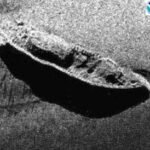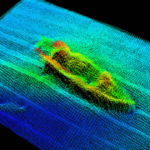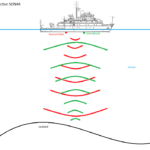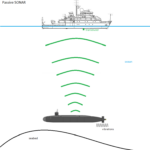SONAR
Tool
Modern
Quick Facts:
SONAR is a tool that allows ships and other vessels to find and identify objects in the water through a system of sound pulses and echoes.
Introduction
Have you ever imagined what the bottom of the ocean floor looks like? With a tool called SONAR we do not have to wonder anymore. It was first used in the early twentieth century primarily as a way to detect submarines. Today, SONAR has many uses in the maritime world, from mapping the seafloor to exploring shipwrecks.
History
SONAR is short for Sound Navigation And Ranging. One of the earliest SONAR-like devices was invented by naval architect Lewis Nixon in 1906. It was designed to detect icebergs underwater to help ships navigate around them. This detection system became more important after the sinking of the Titanic in 1912. But when World War I began in 1914, heavy research into submarine detection became necessary. In 1915, French physicist Paul Langevin worked with Russian engineer Constantin Chilowski to develop the first active SONAR device for detecting submarines.1 This technology continued to improve and was even more helpful by World War II, and is still used on military vessels today.
SONAR technology mostly grew due to naval military use. However, it is very helpful in underwater exploration and is used widely today. Oceanographers are scientists who study the ocean and ocean geography. They use SONAR to map the seafloor, measure water depths, and help find shipwrecks.2 Multibeam SONAR devices allow their images to be viewed even better. By using computer mapping software, they can turn the SONAR echoes or “soundings” into rainbow-colored maps and 3D models.3
How It Works
There are two different types of SONAR. Active SONAR can measure an object’s distance. It sends out loud sound wave called a ping. The ping hits an object. A sound wave bounces back to the receiver, called a transducer. The distance to the object is measured by how long it takes for the ping to travel to the object and back to the transducer. Passive SONAR does not send out a sound wave. It can only listen for sounds. It can tell whether or not something is present by listening for sound waves from objects. Passive SONAR is the method used for detecting submarines by listening for the sound waves of the engines. While SONAR can seem like a technical process, it can best be compared to how a dolphin uses echolocation to hunt.
Endnotes
- Sally Morgan, Sound, (Chicago: Heinemann-Raintree Library, 2007), 48.
- Richard Spilsbury and Louise Spilsbury, Light and Sound, (Chicago: Capstone Global Library, 2014), 21.
- “What do SONAR Echoes Look Like?”, National Oceanic and Atmospheric Administration [NOAA], accessed August 2, 2017, https://oceanservice.noaa.gov/education/seafloor-mapping/sonar_pics.html
Bibliography
- Morgan, Sally. Sound. Chicago: Heinemann-Raintree Library, 2007.
- National Oceanic and Atmospheric Administration [NOAA]. “What do SONAR Echoes Look Like?” Accessed August 2, 2017. https://oceanservice.noaa.gov/education/seafloor-mapping/sonar_pics.html.
- Spilsbury, Richard and Louise Spilsbury. Light and Sound. Chicago: Capstone Global Library, 2014.
Gallery
- SONAR Image USS Monitor wreck (Credit: NOAA)
- Multibeam SONAR image of the USS Monitor (Credit: NOAA)
- Active SONAR diagram
- Passive SONAR diagram





